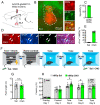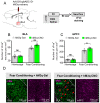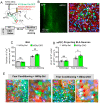Chemogenetic Activation of Astrocytes in the Basolateral Amygdala Contributes to Fear Memory Formation by Modulating the Amygdala-Prefrontal Cortex Communication
- PMID: 35682767
- PMCID: PMC9181030
- DOI: 10.3390/ijms23116092
Chemogenetic Activation of Astrocytes in the Basolateral Amygdala Contributes to Fear Memory Formation by Modulating the Amygdala-Prefrontal Cortex Communication
Abstract
The basolateral amygdala (BLA) is one of the key brain areas involved in aversive learning, especially fear memory formation. Studies of aversive learning in the BLA have largely focused on neuronal function, while the role of BLA astrocytes in aversive learning remains largely unknown. In this study, we manipulated the BLA astrocytes by expressing the Gq-coupled receptor hM3q and discovered that astrocytic Gq modulation during fear conditioning promoted auditorily cued fear memory but did not affect less stressful memory tasks or induce anxiety-like behavior. Moreover, chemogenetic activation of BLA astrocytes during memory retrieval had no effect on fear memory expression. In addition, astrocytic Gq activation increased c-Fos expression in the BLA and the medial prefrontal cortex (mPFC) during fear conditioning, but not in the home cage. Combining these results with retrograde virus tracing, we found that the activity of mPFC-projecting BLA neurons showed significant enhancement after astrocytic Gq activation during fear conditioning. Electrophysiology recordings showed that activating astrocytic Gq in the BLA promoted spike-field coherence and phase locking percentage, not only within the BLA but also between the BLA and the mPFC. Finally, direct chemogenetic activation of mPFC-projecting BLA neurons during fear conditioning enhanced cued fear memory. Taken together, our data suggest that astrocytes in the BLA may contribute to aversive learning by modulating amygdala-mPFC communication.
Keywords: anxiety; astrocytes; basolateral amygdala; chemogenetic; electrophysiology; fear conditioning; medial prefrontal cortex; neurons; projection.
Conflict of interest statement
The authors declare no conflict of interest.
Figures





Similar articles
-
The Role of Basolateral Amygdala and Medial Prefrontal Cortex in Fear: A Systematic Review.Cureus. 2025 Jan 29;17(1):e78198. doi: 10.7759/cureus.78198. eCollection 2025 Jan. Cureus. 2025. PMID: 40026920 Free PMC article. Review.
-
Trace Fear Conditioning Differentially Modulates Intrinsic Excitability of Medial Prefrontal Cortex-Basolateral Complex of Amygdala Projection Neurons in Infralimbic and Prelimbic Cortices.J Neurosci. 2015 Sep 30;35(39):13511-24. doi: 10.1523/JNEUROSCI.2329-15.2015. J Neurosci. 2015. PMID: 26424895 Free PMC article.
-
Synaptic Targeting of Double-Projecting Ventral CA1 Hippocampal Neurons to the Medial Prefrontal Cortex and Basal Amygdala.J Neurosci. 2017 May 10;37(19):4868-4882. doi: 10.1523/JNEUROSCI.3579-16.2017. Epub 2017 Apr 6. J Neurosci. 2017. PMID: 28385873 Free PMC article.
-
Perturbation of GABAergic Synapses at the Axon Initial Segment of Basolateral Amygdala Induces Trans-regional Metaplasticity at the Medial Prefrontal Cortex.Cereb Cortex. 2018 Jan 1;28(1):395-410. doi: 10.1093/cercor/bhx300. Cereb Cortex. 2018. PMID: 29136108
-
The role of the basolateral amygdala and infralimbic cortex in (re)learning extinction.Psychopharmacology (Berl). 2019 Jan;236(1):303-312. doi: 10.1007/s00213-018-4957-x. Epub 2018 Jun 30. Psychopharmacology (Berl). 2019. PMID: 29959461 Review.
Cited by
-
Prefrontal Cortex Astroglia Modulate Anhedonia-like Behavior.Res Sq [Preprint]. 2023 Jun 30:rs.3.rs-3093428. doi: 10.21203/rs.3.rs-3093428/v1. Res Sq. 2023. Update in: Mol Psychiatry. 2023 Nov;28(11):4632-4641. doi: 10.1038/s41380-023-02246-1. PMID: 37461693 Free PMC article. Updated. Preprint.
-
The Role of Basolateral Amygdala and Medial Prefrontal Cortex in Fear: A Systematic Review.Cureus. 2025 Jan 29;17(1):e78198. doi: 10.7759/cureus.78198. eCollection 2025 Jan. Cureus. 2025. PMID: 40026920 Free PMC article. Review.
-
Astroglial Dysfunctions in Mood Disorders and Rodent Stress Models: Consequences on Behavior and Potential as Treatment Target.Int J Mol Sci. 2024 Jun 8;25(12):6357. doi: 10.3390/ijms25126357. Int J Mol Sci. 2024. PMID: 38928062 Free PMC article. Review.
-
Astrocytes in the Ventral Hippocampus Bidirectionally Regulate Innate and Stress-Induced Anxiety-Like Behaviors in Male Mice.Adv Sci (Weinh). 2024 Oct;11(38):e2400354. doi: 10.1002/advs.202400354. Epub 2024 Aug 9. Adv Sci (Weinh). 2024. PMID: 39120568 Free PMC article.
-
Astrocyte and L-lactate in the anterior cingulate cortex modulate schema memory and neuronal mitochondrial biogenesis.Elife. 2023 Nov 14;12:e85751. doi: 10.7554/eLife.85751. Elife. 2023. PMID: 37960975 Free PMC article.
References
-
- Aggleton J.P. The Amygdala: A Functional Analysis. Oxford University Press; Oxford, UK: 2000.
MeSH terms
Grants and funding
- 11103721/General Research Fund, Research Grants Council of Hong Kong
- 11102820/General Research Fund, Research Grants Council of Hong Kong
- 11100018/General Research Fund, Research Grants Council of Hong Kong
- 3171101014, N_CityU114/17/National Natural Science Foundation of China (NSFC) and RGC Joint Research Scheme
- CityU 9445909/Innovation and Technology Fund Hong Kong
LinkOut - more resources
Full Text Sources

